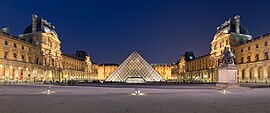
Back Louvre Afrikaans Louvre ALS ሉቭር ሙዚየም Amharic Museu d'o Louvre AN Louvre ANG متحف اللوفر Arabic ܒܝܬ ܥܬܩܐ ܕܠܘܒܪ ARC متحف اللوڤر ARY متحف اللوفر ARZ Muséu del Louvre AST
 The Louvre Museum | |
 | |
| Established | 10 August 1793 |
|---|---|
| Location | Musée du Louvre, 75001, Paris, France |
| Type | Art museum and historic site |
| Collection size | 615,797 in 2019[1] (35,000 on display)[2] |
| Visitors | 8.7 million (2024)[3]
|
| Director | Laurence des Cars |
| Curator | Marie-Laure de Rochebrune |
| Public transit access | |
| Website | louvre.fr |
The Louvre (English: /ˈluːv(rə)/ LOOV(-rə)),[4] or the Louvre Museum (French: Musée du Louvre [myze dy luvʁ] ⓘ), is a national art museum in Paris, France, and one of the most famous museums in the world. It is located on the Right Bank of the Seine in the city's 1st arrondissement (district or ward) and home to some of the most canonical works of Western art, including the Mona Lisa, Venus de Milo, and Winged Victory. The museum is housed in the Louvre Palace, originally built in the late 12th to 13th century under Philip II. Remnants of the Medieval Louvre fortress are visible in the basement of the museum. Due to urban expansion, the fortress eventually lost its defensive function, and in 1546 Francis I converted it into the primary residence of the French kings.[5]
The building was redesigned and extended many times to form the present Louvre Palace. In 1682, Louis XIV chose the Palace of Versailles for his household, leaving the Louvre primarily as a place to display the royal collection, including, from 1692, a collection of ancient Greek and Roman sculpture.[6] In 1692, the building was occupied by the Académie des Inscriptions et Belles-Lettres and the Académie Royale de Peinture et de Sculpture, which in 1699 held the first of a series of salons. The Académie remained at the Louvre for 100 years.[7] During the French Revolution, the National Assembly decreed that the Louvre should be used as a museum to display the nation's masterpieces.
The museum opened on 10 August 1793 with an exhibition of 537 paintings, the majority of the works being royal and confiscated church property. Because of structural problems with the building, the museum was closed from 1796 until 1801. The collection was increased under Napoleon, after the Napoleonic looting of art in Europe, Egypt, and Syria, and the museum was renamed Musée Napoléon, but after Napoleon's abdication, many works seized by his armies were returned to their original owners.[citation needed] The collection was further increased during the reigns of Louis XVIII and Charles X, and during the Second French Empire the museum gained 20,000 pieces. Holdings have grown steadily through donations and bequests since the Third Republic. The collection is divided among eight curatorial departments: Egyptian Antiquities; Near Eastern Antiquities; Greek, Etruscan, and Roman Antiquities; Islamic Art; Sculpture; Decorative Arts; Paintings; Prints and Drawings.
The Musée du Louvre contains approximately 500,000 objects[8] and displays 35,000 works of art in eight curatorial departments with more than 60,600 m2 (652,000 sq ft) dedicated to the permanent collection.[2] The Louvre exhibits sculptures, objets d'art, paintings, drawings, and archaeological finds. At any given point in time, approximately 38,000 objects from prehistory to the 21st century are being exhibited over an area of 72,735 m2 (782,910 sq ft), making it the largest museum in the world. It received 8.7 million visitors in 2024, 200,000 less than 2023, due largely to competition from the 2024 Paris Olympics. In 2023 it was the most-visited museum in the world, ahead of the Vatican Museums.[9][10]
- ^ Cite error: The named reference
rapport2019was invoked but never defined (see the help page). - ^ a b "Louvre Museum". museums.eu.
- ^ [ Louvre press release, 8 January 2025
- ^ The New Oxford American Dictionary gives the respelling "/'loov(rə)/", which has been converted to its IPA equivalent. The portion within parentheses indicates a variant pronunciation.
- ^ "Louvre Museum". Inexhibit. Retrieved 15 October 2016.
- ^ "Louvre Website – Chateau to Museum, 1672 and 1692". Louvre.fr. Archived from the original on 15 June 2011. Retrieved 21 August 2011.
- ^ "Louvre Website – Chateau to Museum 1692". Louvre.fr. Archived from the original on 15 June 2011. Retrieved 21 August 2011.
- ^ "Rapport d'activité 2022" (PDF). Louvre. Archived (PDF) from the original on 15 December 2023.
- ^ "Louvre retains its place as the most-visited art museum in the world". The Art Newspaper - International art news and events. 27 March 2023. Retrieved 17 May 2024.
- ^ "En 2023, le Louvre a retrouvé une fréquentation pré-Covid avec près de 9 millions de visiteurs". 3 January 2024.